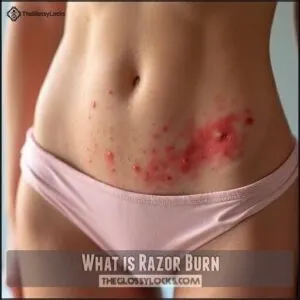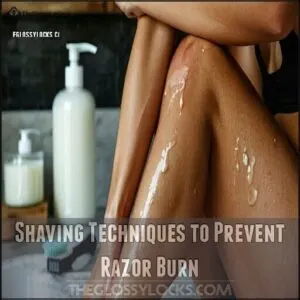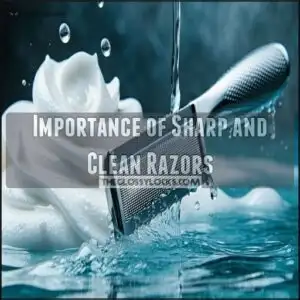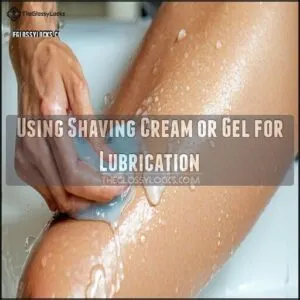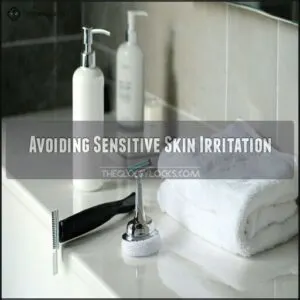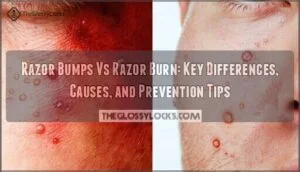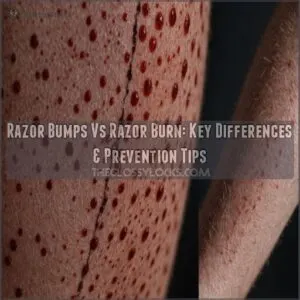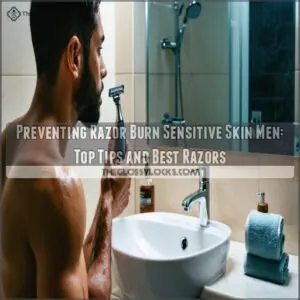This site is supported by our readers. We may earn a commission, at no cost to you, if you purchase through links.
 Razor burn happens when your skin gets irritated during or after shaving.
Razor burn happens when your skin gets irritated during or after shaving.
It’s usually caused by improper techniques, shaving too fast, using dull blades, or skipping important steps like exfoliating and moisturizing.
To prevent it, always use a sharp, clean razor and apply shaving cream or gel for smooth gliding. Shave in the direction your hair grows and avoid pressing too hard.
Prepping your skin by hydrating and exfoliating helps reduce irritation. Avoid tight clothing right after shaving, as it can rub against sensitive skin.
Curious about soothing tips and tricks? There’s more to discover that can keep your skin happy!
Table Of Contents
- Key Takeaways
- What is Razor Burn
- Causes Razor Burn Prevention
- Reducing Razor Burn Risk
- Preventing Razor Burn Occurrence
- Frequently Asked Questions (FAQs)
- How to prevent razor burn?
- Why is it important to avoid sunburn every day?
- What causes razor burn?
- What are the best home remedies for Razor Burn?
- Does shaving with a razor cause razor burn?
- How do you get rid of a razor burn after shaving?
- Can diet or hydration affect razor burn?
- Does hair type influence razor burn likelihood?
- How can men reduce neck razor burn?
- Are electric razors better for razor burn?
- Conclusion
Key Takeaways
- You’ll prevent razor burn by using sharp, clean razors and replacing dull blades regularly, as they drag on your skin and increase irritation.
- You can reduce irritation by applying proper shaving cream or gel for lubrication, creating a protective layer that helps your razor glide smoothly over your skin.
- You should always shave in the direction of hair growth with light pressure, avoiding repeatedly going over the same area to minimize skin damage.
- You’ll benefit from exfoliating 2-3 times weekly to remove dead skin cells, followed by moisturizing with soothing ingredients like aloe vera or shea butter to maintain your skin’s natural barrier.
What is Razor Burn
Razor burn happens when shaving irritates your skin, leaving it red, itchy, and sometimes bumpy.
It’s a common issue that can occur anywhere you shave, especially on sensitive areas like your neck or legs.
Definition and Overview of Razor Burn
Razor burn is a type of shaving irritation that appears as a temporary rash with redness, inflammation, and skin discomfort.
Razor burn feels like your skin’s way of saying, "Slow down, treat me better, and use the right tools!
It’s usually caused by friction or incorrect shaving techniques. This common condition typically affects areas like the face, legs, or underarms.
Recognizing razor burn causes can help you prevent razor burn and reduce post-shave symptoms.
Razor burn, characterized by skin irritation and redness, is different from razor bumps, which is an important distinction to make for effective skin care and prevention.
Symptoms and Affected Areas of Razor Burn
Shaving irritation can leave you with red patches, bumps, and an uncomfortable burning sensation.
Razor burn commonly affects regions like the face, neck, legs, and underarms.
Its itchiness severity varies, sometimes causing mild stinging, and the bump characteristics resemble small, inflamed spots caused by shaving friction.
The redness appearance is immediate, signaling skin irritation from poor techniques or dull razors.
Common Causes of Razor Burn
Using dull razors, dry shaving, and ignoring proper shaving techniques can cause razor burn.
Sensitive skin is more prone to irritation, especially when shaving against the grain or using products with harsh ingredients.
To prevent discomfort, avoid shaving in a hurry or pressing too hard.
With simple shaving tips and razor burn remedies, you can soothe and protect your skin effectively.
Causes Razor Burn Prevention
Razor burn prevention starts with understanding what causes it, like shaving with dull blades or against hair growth.
By improving your technique and using the right tools, you can avoid this common irritation altogether, which is the key to complete prevention.
Economic Impact Of Innovation
Preventing razor burn mirrors the economic impact of innovation.
Just as sharp ideas boost global competitiveness and productivity gains, sharp razors paired with proper shaving techniques can enhance skin health.
Job market shifts embrace new business models; likewise, adopting careful prevention, like moisturizing and following shaving tips, saves you from seeking razor burn remedies later.
Think long-term care, not quick fixes, to ensure that you prioritize your skin health and avoid the need for remedies, which is a key aspect of preventing razor burn.
Role Of Emerging Technologies
Emerging technologies like AI razors and smart skincare devices make razor burn prevention easier.
AI razors adapt to your shaving needs, minimizing irritation. Personalized shaving routines powered by apps reduce skin damage.
Laser treatments even tackle long-term hair removal. Telemedicine consults offer expert razor burn treatment advice instantly.
Innovative skin care products enhance skin irritation prevention for a smoother shave.
Sustainability In Modern Markets
Shaving better doesn’t mean ignoring the planet.
Eco-friendly products with sustainable packaging and ethical sourcing fit right into a green innovation strategy.
These options reduce irritation for sensitive skin shaving while supporting a circular economy.
Post-shave products can further soothe the skin.
The best shaving cream or razor burn treatment isn’t just skin-deep—embracing a sustainable skin care routine helps you and the environment feel smoother.
Reducing Razor Burn Risk
To lower your chances of razor burn, focus on proper shaving techniques and take care of your skin before and after shaving.
Using clean, sharp tools and applying a good shaving cream or gel can make a big difference in reducing irritation.
Shaving Techniques to Prevent Razor Burn
A good shaving technique starts with skin preparation.
Prepare your skin first—warm water softens, exfoliation lifts hairs, and proper steps ensure a smoother, irritation-free shave.
Wash with warm water to soften hairs, then exfoliate to lift them.
Always shave in the hair growth direction using a sharp razor blade for smoother results.
Keep light pressure and avoid re-shaving areas repeatedly.
Adjust your shaving frequency based on your skin’s needs, and finish with proper post-shave care.
Importance of Sharp and Clean Razors
A sharp razor blade makes all the difference when shaving.
Dull blades drag on skin, increasing irritation and razor burn. Cleanliness matters too—a dirty razor can spread bacteria, risking infection.
Using a clean shaving implement reduces this risk.
For better skin health and razor longevity:
- Replace blades regularly.
- Rinse the razor frequently.
- Dry it thoroughly after use.
- Store it in a clean, dry spot.
Using Shaving Cream or Gel for Lubrication
A smooth shave starts with choosing a proper lubricant like shaving cream or gel.
These products create a protective layer, reducing friction and razor burn. Effective cream ingredients soften hair, while gel alternatives help the razor glide effortlessly.
Proper application technique matters—cover all areas evenly for the best results. Many prefer gel for lubrication.
Enjoy post-shave benefits, including hydrated, irritation-free skin.
Avoiding Sensitive Skin Irritation
Sensitive skin needs extra care to prevent shaving irritation. Start with a pre-shave routine like cleansing and exfoliating to protect against razor burn.
Use products with gentle ingredients and avoid fragrances or alcohol. Choose a razor designed for sensitive skin, and always shave with the grain.
Post-shave care, like applying fragrance-free moisturizers, helps soothe and protect irritated skin. To further reduce irritation, consider softening facial hair before shaving to prevent razor burn and ensure proper care.
Preventing Razor Burn Occurrence
To prevent razor burn, focus on keeping your skin healthy and properly prepared before shaving. Simple habits like exfoliating, moisturizing, and using the right tools can substantially reduce irritation.
Exfoliating and Moisturizing to Prevent Razor Burn
Exfoliating skin removes dead cells, reducing razor burn risk and promoting smoother shaves.
Aim for gentle exfoliation 2-3 times weekly to avoid skin inflammation. Follow with a suitable moisturizer—like aloe vera or shea butter—to lock in hydration and repair.
Post-exfoliation care is essential; hydrate immediately to preserve skin’s natural barrier, preventing irritation. Proper skin care minimizes discomfort effectively.
Many people find a suitable razor burn exfoliant helpful in their routine to achieve smoother shaves and reduce skin inflammation with proper skin care.
Avoiding Tight Clothing and Excessive Sweating
Loose and breathable fabrics are your post-shave allies.
Tight clothing increases friction and traps sweat, both of which can irritate freshly shaved skin.
Opt for materials like cotton or bamboo to enhance skin breathability.
Managing sweat and preventing fabric rubbing helps reduce skin inflammation.
Simple steps like these guarantee better skin care and sidestep potential skin conditions caused by irritation.
Applying Soothing Creams and Ointments for Relief
After shaving, soothing your skin helps combat irritation.
Post-shave care with aloe vera or an oatmeal bath can calm redness quickly.
Hydrocortisone benefits include reducing itching and inflammation, but use it sparingly.
Natural oil soothers like coconut oil hydrate while easing discomfort.
A moisturizing skin aftershave balm also promotes healing, offering lasting skin soothing and relief from skin irritation solutions.
Thick shaving cream can provide a smooth glide.
Frequently Asked Questions (FAQs)
How to prevent razor burn?
Think of shaving like gardening—prep the "soil" to avoid irritation.
Use a sharp razor, shaving cream, and warm water. Go with hair growth, take light strokes, and moisturize after.
Replace dull blades regularly.
Why is it important to avoid sunburn every day?
Protecting yourself from sunburn daily prevents painful redness, peeling, and long-term skin damage.
Frequent overexposure increases your risk of premature aging and skin cancer.
Use sunscreen or protective clothing to stay safe and avoid these risks.
What causes razor burn?
Razor burn, like a bee sting for your skin, happens when you shave improperly—using a dull blade, dry shaving, or going against hair growth.
Sensitive skin and skipping lubrication only make it worse.
What are the best home remedies for Razor Burn?
Try soothing razor burn with aloe vera, a cool compress, or coconut oil.
An oatmeal bath can calm irritation, while diluted tea tree oil or hydrocortisone cream reduces redness.
Skip shaving until your skin heals.
Does shaving with a razor cause razor burn?
Yes, shaving with a razor can cause razor burn, especially if you shave dry, use a dull blade, or go against hair growth.
It’s all about technique—shave gently, moisturize, and use clean tools.
How do you get rid of a razor burn after shaving?
To treat razor burn, apply aloe vera or a cool compress to soothe irritation.
Use a hydrating moisturizer or over-the-counter hydrocortisone cream to reduce redness.
Avoid shaving the area until the skin fully heals.
Can diet or hydration affect razor burn?
Your skin health starts from within. Proper hydration and a nutrient-rich diet can strengthen your skin’s barrier function, potentially reducing susceptibility to razor burn when you’re shaving sensitive areas.
Does hair type influence razor burn likelihood?
Yes, your hair type substantially impacts razor burn risk.
Coarse, curly hair is more prone to irritation as it often grows at angles or curls back into skin.
You’ll need extra care when shaving these hair types, especially with coarse, curly hair.
How can men reduce neck razor burn?
Like a knight preparing for battle, prep your neck with warm water and shaving cream.
Always shave with the grain using a sharp razor, apply witch hazel afterward, and moisturize regularly.
Are electric razors better for razor burn?
Electric razors typically cause less irritation than manual razors since they don’t cut as close to your skin.
You’ll find they’re particularly helpful if you’ve got sensitive skin prone to frequent razor burn.
Conclusion
By implementing proper shaving techniques, you’ll bid farewell to that fiery nemesis known as razor burn.
Remember what causes razor burn prevention: sharp blades, proper lubrication, and following hair growth direction.
You’re not just shaving—you’re conducting a delicate operation that your skin deserves!
With regular exfoliation and moisturizing, you’ll maintain smooth, irritation-free skin. Don’t rush the process; your skin’s happiness is worth those extra minutes of care.

